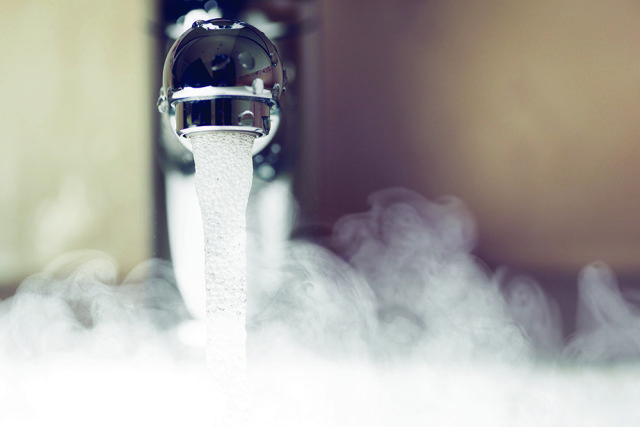Getting water right

Raymond Kelly addresses the importance of water system design for health and wellbeing, and highlights some of the legislation around this life-critical element.
At the very core of correct design of domestic water systems, is the protection of the health and wellbeing of people, both in terms of the direct use of any facilities which are provided with water services, and in the wider context of general proximity to the locations where facilities are being used.
In the UK, the quality of water supplied for distribution to, and for use by persons and properties is controlled by UK and Scottish Acts of Parliament. Although responsibility for enforcement of these regulations is generally ministerial, and therefore undertaken by parties such as OFWAT and the Water Industry Commission for Scotland, it is water suppliers which enforce the Water Fittings Regulations and Bylaws.
These set down detailed national requirements for the design, installation, operation and maintenance of plumbing systems, water fittings and water-using appliances. They are designed to prevent misuse, waste, undue consumption or erroneous measurement of water, and to prevent drinking water contamination.
Various government watchdogs also exist for drinking water, including the Drinking Water Inspectorate in England and Wales, the Drinking Water Inspectorate (Northern Ireland), and the Drinking Water Quality Regulator in Scotland. In addition, the Health & Safety Executive also publishes guidance and codes of practice relating to domestic water services, which have special legal status.
The World Health Organisation notes that: “Water is essential for life. The amount of fresh water on earth is limited, and its quality is under constant pressure. Preserving the quality of fresh water is important for the drinking-water supply, food production and recreational water use. Water quality can be compromised by the presence of infectious agents, toxic chemicals, and radiological hazards.”
However, it is estimated that only about 2.5% of water on Earth is fresh and even less of that is safe to drink, with changes in the climate being cited as the reason for the amount of rain and ice melts from winter dropping off and lowering the reserve supplies of freshwater available. While efficient water usage management is necessary to comply with national and international environmental conservation best practice aims, a direct benefit is a significant reduction in cost. Reduced water consumption is therefore a commercial driver to introduce efficient water supply systems.
For most buildings where mains water is available, using the mains supply will be the most effective way to meet users’ water needs, and when using mains water, specifying efficient fixtures, appliances and water-heating systems can reduce a building’s environmental impact.
Even if there is a mains connection available, harvested rainwater can be used to meet some of a building’s demand for water and could reduce mains supplied water by up to 50% For example, filtered rainwater and greywater (from showers, basins and baths) can be recycled to meet demand for non-potable water use, such as gardening, flushing toilets, bathing and clothes washing.
Other efficient and environmentally friendly water supply solutions, such as low water volume flush toilets, the use of urinal cistern controls and low flow terminal fittings, for tap outlets and showers, also deliver quantifiable water consumption savings. Unlike rainwater and grey water recycling, these solutions require little or no additional plant space and maintenance, making them easier to introduce into a typical system design. Leak detection systems can also be deployed, to which alert building users, with automatic shut off facilities preventing major water wastage.
The efficient management of water usage and supplies is necessary to comply with national and international environmental conservation “best practice” aims, but the direct benefits of introducing water efficient solutions should be significant reduction in water consumption, and therefore similar reductions in costs for water usage.
BREEAM is one of the property industry’s recognised benchmarks for the environmental rating of new and major refurbished buildings. In relation to water supply design it broadly aims to:
• Reduce the consumption of potable water for sanitary use in new buildings by using water efficient components and recycling systems.
• Ensure water consumption can be monitored and managed to encourage reduction.

• Reduce the impact of water leaks that may otherwise go undetected.
• Encourage the specification of water efficient equipment.
Health and wellbeing and the quality of the water supply must remain the key considerations when introducing efficient, environmentally friendly water supply measures. From a practical point of view, this necessitates a good match between the measure to be employed and the efficiency aspect targeted.
Too often, complaints of poor water performance are the result of over-designed conservation measures which push a solution that isn’t compatible with the installation type. For example, using restricting devices to minimise water use may not be suitable for appliances which require specific flow rates to operate effectively, or where their use may introduce an additional health hazard such as in Healthcare.
Underestimating design requirements at an early stage, as well as overdesigning and a lack of attention to detail can lead to a variety of operational issues. For example, over-sizing the specification of cold-water storage tanks can lead to stagnation, whilst under-sizing could cause demand-supply problems.
Unfortunately, a ‘one size fits all’ attitude often applies as a consequence of information technology development. Water services design is no exception, where phrases such as “that building is easy, it’s copy and paste from the last one” are familiar. The importance of design evolution and time to think are increasingly seen as a thing of the past in this highly digital and automated age. Consequently, a lack of real understanding and / or unwillingness to accept the rationale of the importance of correctly designed systems can be a huge barrier to designers.
Likewise, financial pressures can create barriers to the optimum design solution. For example, often cold-water storage plant space is shared with heat-producing plant, usually because there is pressure to reduce net floor area and increase cost savings by minimising plant space in a building. This warming effect on the cold-water supply can potentially introduce the risk of bacterial propagation in the water supply. Such a circumstance usually occurs due to those external pressures and a lack of knowledge or awareness of the implications in relation to reduced water quality and risk of bacterial propagation, for example in the case of Legionellae infection
While adherence to water standards and regulations should ensure a level of compliant design, modern buildings and the drive for energy efficiency have created unintended consequences. As heat produced in a modern building no longer “leaks out”, it can introduce additional heat to the cold-water distribution system. The result is a risk of infection and proliferation of Legionella and similar bacterial infections. Likewise, the drive for fittings which minimise water consumption and the recycling of used water has created a need for new standards to specify pipe and plant sizing, as without it new systems could be over-designed.
The reality is that no two water system design engineering projects are ever the same. Often subtle differences between two similar projects can bring significant issues and outcomes in terms of plant and pipe sizing, and the resulting system’s performance. Best practice advice when evaluating efficient measures for inclusion in water supply systems would therefore be to maintain focus on the health and wellbeing of end-users, and not to allow efficiency to lead to compromises in system performance or contamination of the water system.
Raymond Kelly is associate at TÜV SÜD
Picture credit: Shutterstock/nikkytok







